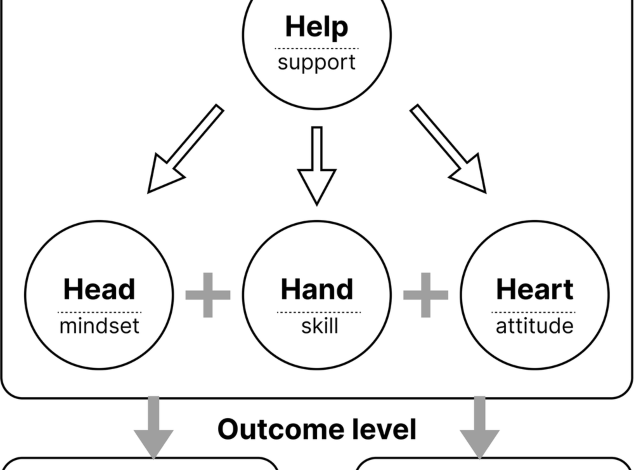Designing a framework for entrepreneurship education in Chinese higher education: a theoretical exploration and empirical case study

TH theory
The notion of TH first appeared in the early 1980s, coinciding with the global transition from an industrial to a knowledge-based economy (Cai & Etzkowitz, 2020). At that time, the dramatic increase in productivity led to overproduction, and knowledge became a valuable mechanism for driving innovation and economic growth (Mandrup & Jensen, 2017). Recognizing the potential of incorporating cutting-edge university technologies into industry and facilitating technology transfer and innovation, the US government took proactive steps to enhance the international competitiveness of American industries. This initiative culminated in the enactment of relevant legislation in 1980, which triggered a surge in technology transfer, patent licensing, and the establishment of new enterprises within the United States. Subsequently, European and Asian nations adopted similar measures, promoting the transformation of universities’ identity (Grimaldi et al., 2011). Universities assumed a central role in technology transfer, the formation of businesses, and regional revitalization within the knowledge society rather than occupying a secondary position within the industrial community. The conventional one-to-one relationships between universities, companies, and the government evolved into a dynamic TH model (Cai & Etzkowitz, 2020). Beyond their traditional roles in knowledge creation, wealth production, and policy coordination, these sectors began to engage in multifaceted interactions, effectively “playing the role of others” (Ranga & Etzkowitz, 2013).
The TH model encompasses three fundamental elements: 1) In a knowledge-based society, universities assume a more prominent role in innovation than in industry; 2) The three entities engage in collaborative relationships, with innovation policies emerging as a result of their mutual interactions rather than being solely dictated by the government; and 3) Each entity, while fulfilling its traditional functions, also takes on the roles of the other two parties (Henry, 2009). This model is closely aligned with EE.
On the one hand, EE can enhance the effectiveness of TH theory by strengthening the links between universities, industry, and government. The TH concept was developed based on entrepreneurial universities. The emerging entrepreneurial university model integrates economic development as an additional function. Etzkowitz’s research on the entrepreneurial university identified a TH model of academia-industry-government relations implemented by universities in an increasingly knowledge-based society (Galvao et al., 2019). Alexander and Evgeniy (2012) articulated that entrepreneurial universities are crucial to the implementation of triple-helix arrangements and that by integrating EE into their curricula, universities have the potential to strengthen triple-helix partnerships and boost the effectiveness of the triple-helix model.
On the other hand, TH theory also drives EE to achieve high-quality development. Previously, universities were primarily seen as sources of knowledge and human resources. However, they are now also regarded as reservoirs of technology. Within EE and incubation programs, universities are expanding their educational capabilities beyond individual education to shaping organizations (Henry, 2009). Surpassing their role as sources of new ideas for existing companies, universities blend their research and teaching processes in a novel way, emerging as pivotal sources for the formation of new companies, particularly in high-tech domains. Furthermore, innovation within one field of the TH influences others (Piqué et al., 2020). An empirical study by Alexander and Evgeniy (2012) outlined how the government introduced a series of initiatives to develop entrepreneurial universities, construct innovation infrastructure, and foster EE growth.
Overview of EE
EE occupies a crucial position in driving economic advancement, and this domain has been the focal point of extensive research. Fellnhofer (2019) examined 1773 publications from 1975 to 2014, introducing a more closely aligned taxonomy of EE research. This taxonomy encompasses eight major clusters: social and policy-driven EE, human capital studies related to self-employment, organizational EE and TH, (Re)design and evaluation of EE initiatives, entrepreneurial learning, EE impact studies, and the EE opportunity-related environment at the organizational level. Furthermore, Mohamed and Sheikh Ali (2021) conducted a systematic literature review of 90 EE articles published from 2009 to 2019. The majority of these studies focused on the development of EE (32%), followed by its benefits (18%) and contributions (12%). The selected research also addressed themes such as the relationship between EE and entrepreneurial intent, the effectiveness of EE, and its assessment (each comprising 9% of the sample).
Spanning from 1975 to 2019, these two reviews offer a comprehensive landscape of EE research. The perspective on EE has evolved, extending into multiple dimensions (Zaring et al., 2021). However, EE does not always achieve the expected outcomes, as challenges such as limited student interest and engagement as well as persistent negative attitudes are often faced (Mohamed & Sheikh Ali, 2021). In fact, the challenges faced by EE in most countries may be similar. However, the solutions may vary due to contextual differences (Fred Awaah et al., 2023). Furthermore, due to this evolution, there is a need for a more comprehensive grasp of pedagogical concepts and the foundational elements of modern EE (Hägg & Gabrielsson, 2020). Based on the objectives of this study, four specific themes were chosen for an in-depth literature review: the objectives, contents and methods, outcomes, and experiences of EE.
Objectives of EE
The objectives of EE may provide significant guidance for its implementation and the assessment of its effectiveness, and EE has evolved to form a diversified spectrum. Mwasalwiba (2010) presented a multifaceted phenomenon in which EE objectives are closely linked to entrepreneurial outcomes. These goals encompass nurturing entrepreneurial attitudes (34%), promoting new ventures (27%), contributing to local community development (24%), and imparting entrepreneurial skills (15%). Some current studies still emphasize particular dimensions of these goals, such as fostering new ventures or value creation (Jones et al., 2018; Ratten & Usmanij, 2021). These authors further stress the significance of incorporating practical considerations related to the business environment, which prompts learners to contemplate issues such as funding and resource procurement. This goal inherently underscores the importance of entrepreneurial thinking and encourages learners to transition from merely being students to developing entrepreneurial mindsets.
Additionally, Kuratko and Morris (2018) posit that the goal of EE should not be to produce entrepreneurs but to cultivate entrepreneurial mindsets in students, equipping them with methods for thinking and acting entrepreneurially and enabling them to perceive opportunities rapidly in uncertain conditions and harness resources as entrepreneurs would. While the objectives of EE may vary based on the context of the teaching institution, the fundamental goal is increasingly focused on conveying and nurturing an entrepreneurial mindset among diverse stakeholders. Hao’s (2017) research contends that EE forms a comprehensive system in which multidimensional educational objectives are established. These objectives primarily encompass cultivating students’ foundational qualities and innovative entrepreneurial personalities, equipping them with essential awareness of entrepreneurship, psychological qualities conducive to entrepreneurship, and a knowledge structure for entrepreneurship. Such a framework guides students towards independent entrepreneurship based on real entrepreneurial scenarios.
Various studies and practices also contain many statements about entrepreneurial goals. The Entrepreneurship Competence Framework, which was issued by the EU in 2016, delineates three competency domains: ideas and opportunities, resources and action. Additionally, the framework outlines 15 specific entrepreneurship competencies (Jun, 2017). Similarly, the National Content Standards for EE published by the US Consortium encompass three overarching strategies for articulating desired competencies for aspiring entrepreneurs: entrepreneurial skills, ready skills, and business functions (Canziani & Welsh, 2021). First, entrepreneurial skills are unique characteristics, behaviors, and experiences that distinguish entrepreneurs from ordinary employees or managers. Second, ready skills, which include business and entrepreneurial knowledge and skills, are prerequisites and auxiliary conditions for EE. Third, business functions help entrepreneurs create and operate business processes in business activities. These standards explain in the broadest terms what students need to be self-employed or to develop and grow a new venture. Although entrepreneurial skills may be addressed in particular courses offered by entrepreneurship faculties, it is evident that business readiness and functional skills significantly contribute to entrepreneurial success (Canziani & Welsh, 2021).
Contents and methods of EE
The content and methods employed in EE are pivotal factors for ensuring the delivery of high-quality entrepreneurial instruction, and they have significant practical implications for achieving educational objectives. The conventional model of EE, which is rooted in the classroom setting, typically features an instructor at the front of the room delivering concepts and theories through lectures and readings (Mwasalwiba, 2010). However, due to limited opportunities for student engagement in the learning process, lecture-based teaching methods prove less effective at capturing students’ attention and conveying new concepts (Rahman, 2020). In response, Okebukola (2020) introduced the Culturo-Techno-Contextual Approach (CTCA), which offers a hybrid teaching and learning method that integrates cultural, technological, and geographical contexts. Through a controlled experiment involving 400 entrepreneurship development students from Ghana, CTCA has been demonstrated to be a model for enhancing students’ comprehension of complex concepts (Awaah, 2023). Furthermore, learners heavily draw upon their cultural influences to shape their understanding of EE, emphasizing the need for educators to approach the curriculum from a cultural perspective to guide students in comprehending entrepreneurship effectively.
In addition to traditional classroom approaches, research has highlighted innovative methods for instilling entrepreneurial spirit among students. For instance, students may learn from specific university experiences or even engage in creating and running a company (Kolb & Kolb, 2011). Some scholars have developed an educational portfolio that encompasses various activities, such as simulations, games, and real company creation, to foster reflective practice (Neck & Greene, 2011). However, some studies have indicated that EE, when excessively focused on applied and practical content, yields less favorable outcomes for students aspiring to engage in successful entrepreneurship (Martin et al., 2013). In contrast, students involved in more academically oriented courses tend to demonstrate improved intellectual skills and often achieve greater success as entrepreneurs (Zaring et al., 2021). As previously discussed, due to the lack of a coherent theoretical framework in EE, there is a lack of uniformity and consistency in course content and methods (Ribeiro et al., 2018).
Outcomes of EE
Research on the outcomes of EE is a broad and continually evolving field, with most related research focusing on immediate or short-term impact factors. For example, Anosike (2019) demonstrated the positive effect of EE on human capital, and Chen et al. (2022) proposed that EE significantly moderates the impact of self-efficacy on entrepreneurial competencies in higher education students through an innovative learning environment. In particular, in the comprehensive review by Kim et al. (2020), six key EE outcomes were identified: entrepreneurial creation, entrepreneurial intent, opportunity recognition, entrepreneurial self-efficacy and orientation, need for achievement and locus of control, and other entrepreneurial knowledge. One of the more popular directions is the examination of the impact of EE on entrepreneurial intentions. Bae et al. (2014) conducted a meta-analysis of 73 studies to examine the relationship between EE and entrepreneurial intention and revealed little correlation. However, a meta-analysis of 389 studies from 2010 to 2020 by Zhang et al. (2022) revealed a positive association between the two variables.
Nabi et al. (2017) conducted a systematic review to determine the impact of EE in higher education. Their findings highlight that studies exploring the outcomes of EE have primarily concentrated on short-term and subjective assessments, with insufficient consideration of longer-term effects spanning five or even ten years. These longer-term impacts encompass factors such as the nature and quantity of startups, startup survival rates, and contributions to society and the economy. As noted in the Eurydice report, a significant impediment to advancing EE is the lack of comprehensive delineation concerning education outcomes (Bourgeois et al., 2016).
Experiences in the EE system
With the deepening exploration of EE, researchers have turned to studying university-centered entrepreneurship ecosystems (Allahar and Sookram, 2019). Such ecosystems are adopted to fill gaps in “educational and economic development resources”, such as entrepreneurship curricula. A growing number of universities have evolved an increasingly complex innovation system that extends from technology transfer offices, incubators, and technology parks to translational research and the promotion of EE across campuses (Cai & Etzkowitz, 2020). In the university context, the entrepreneurial ecosystem aligns with TH theory, in which academia, government, and industry create a trilateral network and hybrid organization (Ranga & Etzkowitz, 2013).
The EE system is also a popular topic in China. Several researchers have summarized the Chinese experience in EE, including case studies and overall experience, such as the summary of the progress and system development of EE in Chinese universities over the last decade by Weiming et al. (2013) and the summary of the Chinese experience in innovation and EE by Maoxin (2017). Other researchers take an in-depth look at the international knowledge of EE, such as discussions on the EE system of Denmark by Yuanyuan (2015), analyzes of the ecological system of EE at the Technical University of Munich by Yubing and Ziyan (2015), and comparisons of international innovation and EE by Ke (2017).
In general, although there has been considerable discussion on EE, the existing body of work has not properly addressed the practical challenges faced by EE in China. On the one hand, the literature is fragmented and has not yet formed a unified and mature theoretical framework. Regarding what should be taught and how it can be taught and assessed, the answers in related research are ambiguous (Hoppe, 2016; Wong & Chan, 2022). On the other hand, current research lacks empirical evidence in the context of China, and guidance on how to put the concept of EE into practice is relatively limited. These dual deficiencies impede the effective and in-depth development of EE in China. Consequently, it is imperative to comprehensively redefine the objectives and contents of EE to provide clear developmental guidance for Chinese higher education institutions.



